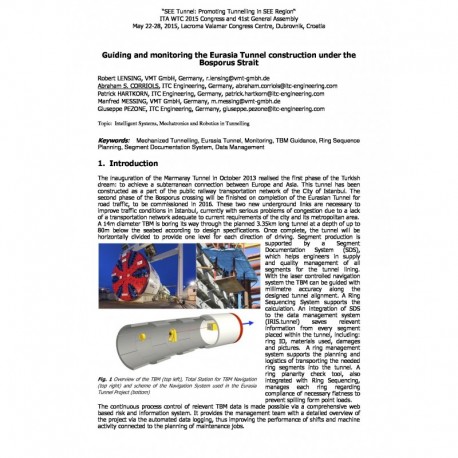Cart
0
0
No document
0,00 €
Total
Document successfully added to your shopping cart
Quantity
Total
There are 0 items in your cart.
There is 1 item in your cart.
Total documents
Total shipping
To be determined
Total
Search & filter
Search for a publication
Search & filter

Guiding and monitoring the Eurasia Tunnel construction under the Bosporus Strait
wtc2015_full_lensing
M. Messing / A. S. Corriols / R. Lensing / P. Hartkorn / G. Pezone
The inauguration of the Marmaray Tunnel in October 2013 realised the first phase of the Turkish dream: to achieve a subterranean connection between Europe and Asia. This tunnel has been constructed as a part of the public railway transportation network of the City of Istanbul. The second phase of the Bosporus crossing will be finished on completion of the Eurasian Tunnel for road traffic, to be commissioned in 2016. These two new underground links are necessary to improve traffic conditions in Istanbul, currently with serious problems of congestion due to a lack of a transportation network adequate to current requirements of the city and its metropolitan area. A 14m diameter TBM is boring its way through the planned 3.35km long tunnel at a depth of up to 80m below the seabed according to design specifications. Once complete, the tunnel will be horizontally divided to provide one level for each direction of driving. Segment production is supported by a Segment Documentation System (SDS), which helps engineers in supply and quality management of all segments for the tunnel lining. With the laser controlled navigation system the TBM can be guided with millimetre accuracy along the designed tunnel alignment. A Ring Sequencing System supports the calculation. An integration of SDS to the data management system (IRIS.tunnel) saves relevant information from every segment placed within the tunnel, including: ring ID, materials used, damages and pictures. A ring management system supports the planning and logistics of transporting the needed ring segments into the tunnel. A ring planarity check tool, also integrated with Ring Sequencing, manages each ring regarding compliance of necessary flatness to prevent spilling form point loads. The continuous process control of relevant TBM data is made possible via a comprehensive web based risk and information system. It provides the management team with a detailed overview of the project via the automated data logging, thus improving the performance of shifts and machine activity connected to the planning of maintenance jobs.


